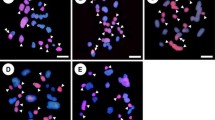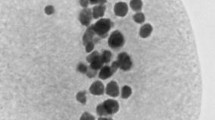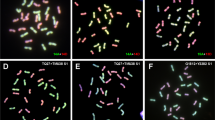Summary
Cytological studies of wild diploid Arachis species in the same section of the genus (sect. Arachis) as the cultivated peanut A. hypogaea L. show, with one exception, a karyotype characterized by the presence of 9 pairs of larger chromosomes and one pair of small (‘A’) chromosomes. The exceptional species A. batozocoi Krap. et Greg. has a more uniform karyotype. Interspecific hybrids between diploid species of similar karyotype have moderate to high pollen stainability, those involving A. batizocoi have zero pollen stainability and a very irregular PMC meiosis. Such infertile hybrids are the most likely to produce fertile, stable amphidiploids on doubling the chromosome complement. It is suggested that the cultivated peanut could have originated from such a sterile interspecific hybrid and on morphological and phytogeographic grounds the most likely genome donors are A. cardenasii (nomen nudum) and A. batizocoi of the species within section Arachis, which have been collected up to the present time.
Similar content being viewed by others
References
Gibbons R. W., 1966. The branching habit of Arachis monticola. Rhod. Zamb. Mal. J. Agric. Res. 4: 9–11.
Gibbons, R. W., A. H. Bunting & J. Smartt, The classification of varieties of groundnut (Arachis hypogaea L.). Euphytica 21: 78–85.
Gibbons, R. W. & A. C. Turley, 1967. ARC grain legume pathology research team-Botany and plant breeding, pp. 86–90. Annual Report of the Agricultural Research Council of Central Africa.
Gregory W. C. & M.Pfluge Gregory, 1976. Groundnuts, pp. 151–154. In: N. W.Simmonds (Ed.), Evolution of crop plants. Longman Group, Ltd., London.
Gregory W. C., M.Pfluge Gregory, A.Krapovickas, B. W.Smith & J. A.Yarbrough, 1973. Structures and genetic resources of peanuts. Chapter 3, pp. 47–133. Peanuts-Cultures and uses. The Amer. Peanut Res. and Educ. Asso., Inc., Stillwater, Oklahoma.
Husted L., 1933. Cytological studies of the peanut Arachis. I. Chromosome number and morphology. Cytologia 5: 109–117.
Husted L., 1936. Cytological studies of the peanut Arachis. II. Chromosome number, morphology and behavior and their application to the origin of cultivated forms. Cytologia 7: 396–423.
Krapovickas A., 1968. Origen, variabilidad y difusion del mani (Arachis hypogaea). Actas y Memorias XXXVII Congreso Internacional Americanistas 2: 517–53. English translation in: P. J. Ucko & G. W. Dimbleby (Eds), 1969, The domestication and exploitation of plants and animals, pp. 427–441. Duckworth, London.
Krapovickas A., 1973. Evolution of the genus Arachis. In: Moav (Ed.), Agricultural genetics — Selected topics. Wiley, New York.
Krapovickas A., A.Fernandez & P.Seeligman, 1974. Recuperacion de la fertilidad en un hibrido interspecifico esteril de Arachis (Leguminosae). Bonplandia 3: 129–142.
Krapovickas A. & V. A.Rigoni, 1951. Estudios citologicos en el genera Arachis. Rev. Invest. agric. (B. Aires) 5: 289–294.
Krapovickas A. & V. A.Rigoni, 1957. Nuevas especies de Arachis vinculadas al problem del origen del mani cultivado. Idia (B Aires) 197: 106–108.
Mendes A. J. T., 1947. Estudios citologicos no genero Arachis. Bragantia 7: 257–267.
Raman V. S., 1958. Studies in the genus Arachis. II. Chromosome numbers of certain species of Arachis. Indian Oilseeds J. 2: 70–73.
Raman V. S., 1959. Studies in the genus Arachis. IV. Investigation on 30-chromosomed interspecific hybrids. I dian Oilseeds J. 3: 157–161.
Raman V. S., 1960. Studies in the genus Arachis. IX. A fertile synthetic tetraploid groundnut from the interspecific backcross A. hypogaea x A. villosa. Indian Oilseeds J. 4: 90–92.
Raman V. S., 1976. Cytogenetics and breeding in Arachis. Today & Tomorrow's Printers and Publishers. New Delhi. 84 p.
Raman V. S. & P. C.Kesavan, 1962. Studies on a diploid interspecific hybrid in Arachis. Nucleus (Calcutta) 5: 123–126.
Smartt, J., 1964. Cross-compatibility relationships between the cultivated peanut Arachis hypogaea L. and other species of the genus Arachis. PhD thesis, North Carolina State University at Raleigh.
Smartt J. & W. C.Gregory, 1967. Interspecific cross-compatibility between the cultivated peanut Arachis hypogaea L. and other members of the genus Arachis. Oléagineux 22: 455–459.
Tjio J. H. & A.Levan, 1950. The use of oxyquinoline in chromosome analysis. Ann. Estac. exp. Aula Dei 2: 21–64.
Varisai Muhammad S., 1973. Cytogenetical investigation in the genus Arachis L. Interspecific hybrids between diploids. Madres agric. J. 60: 323–327.
Author information
Authors and Affiliations
Additional information
Paper number 5560 of the Journal Series of the North Carolina Agricultural Experiment Station, Raleigh, NC 27650
Rights and permissions
About this article
Cite this article
Smartt, J., Gregory, W.C. & Gregory, M.P. The genomes of Arachis hypogaea. 1. Cytogenetic studies of putative genome donors. Euphytica 27, 665–675 (1978). https://doi.org/10.1007/BF00023701
Received:
Issue Date:
DOI: https://doi.org/10.1007/BF00023701




